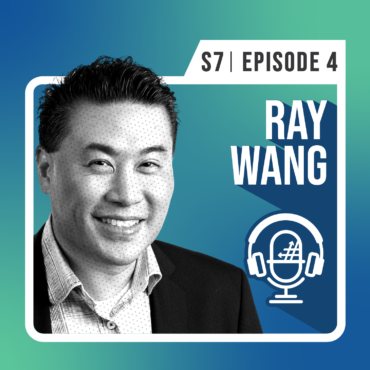S7 E4: Navigating Digital Disruption with R. “Ray” Wang

Do you have what it takes to rule the world? Spoiler alert, the game has changed. The real currency now is data and the players that can leverage it are set to come out on top.
Today, I’m thrilled to speak with Consultant Visionary and Author, Ray Wang. His latest book, ‘Everybody Wants to Rule the World’, offers a fascinating look at business disruption and what you can do to be ready at this new reality brought by the pandemic.
Let’s get into it.
In this episode:
The birth of ‘Everybody Wants to Rule the World’
So here I am in the middle of the pandemic and I’ve got boxes everywhere. I’m like, all right, “I need to clear something out to make this basement work because I’ve got space down there and I need to do something with it.” I used to be a vinyl DJ. I still DJ once in a while in some clubs. So, I have boxes and boxes of media—CDs, records, mini disks, laser discs.
I was putting stuff away and filing it, and I’m just like, “Why am I still doing all this stuff? Why is this all sitting here? Everything’s been digitized. The digital business models are there. You don’t own music.” In fact, I can access all this stuff. I don’t need to carry anything with me. I just show up at a place and just connect to the internet and be there.
And then I realized I’m a victim of being in the middle of a trend and not realizing what’s been going on. Digital channels, digital business models, and digital monetization has all happened in this business. And I’m obsolete. You’re sitting here thinking of all these things, and you’re just like, “Oh my God, this digital revolution is so much bigger. It’s affecting every part of our lives. And of course, it’s affecting the way we work.”
The new landscape: the age of digital information
I think if the pandemic had occurred three years ago, we wouldn’t be having these conversations. Because the technology wasn’t ready, the network reliability wasn’t there. But what happened is, we had such great reliability in terms of accessing things. We didn’t think about backups anymore. And the way we work even changed.
Think about 18 months ago, people were going to meetings every Friday, or maybe every Monday morning, to learn about the things that happened last week. But now, we suddenly were living in the information in real time, which never happened before. We realized that we had the infrastructure live real-time to support remote work. We have the infrastructure to be able to actually make decisions and forecast in the way we weren’t able to do before.
And I think that’s what gave people the confidence—when they could see that we could understand every part of the business. Once it’s digitized, we now have an understanding of what can happen and forecast what might happen and prevent things from happening that we might not like. We started to understand what we need to do to protect ourselves and what we need to do to open up access. And that to me was very powerful.
Digital transformations
Today, everybody tries to remake themselves; rebrand themselves. Companies typically start out with a dynamic founder and that’s the catalyst. They’ve got a great idea. They understand the mission. They understand why they exist. They get people excited, right? And then you’d just go out and find the best people you can. You build these talent networks, you become the best place to work. You attract everyone to come build this great product, this great company along the way. And you keep expanding. And then you go public. You get a lot of growth. The people come in and they scale up the business.
But then everything becomes profit per employee, profit per sale, revenue per employee. And you start to lose it. Companies that are middle aged—30 to 40 years out—they don’t know why they exist. And so here they are trying to do digital transformation, and they’ve got a digital channel working, they’ve got their workers doing remote work. They’re trying to get Teams and collaboration and Office 365 moving along, and they forget why they’re in existence.
And so, typically what happens is, an owner operator comes in, they figure out how to change the environment. They change the cap table. They improve what happens and grab the right talent back into the organization. They think about a new technology—cloud, AI, augmented reality, and virtual reality. And they use that as a catalyst to revamp the product. And then they look at markets, but they don’t look at markets the same way. It’s not about geos. It’s not about industries. It’s about data value chains. And how do you get data value chains? How do we build 4-way marketplaces, foresighted marketplaces, so that we can actually move data along and share that?
And then the last piece is really educating the clients and educating the board what your long-term vision is. You might lose some money on the way there, but here’s what we’re going to do to get there. And I think that’s what you need to do to make that turnaround successful. Because digital transformation on its own, it’s a technology, you’ve got to think and rethink your organization.
Food delivery app companies: an example
These last 18 months, food delivery app companies are kicking butt. Think about what happened. Small businesses who could not deliver their pizza—they went to food delivery apps, right? And GrubHub, Postmates, Uber Eats, Door Dash, they all picked up. These food delivery apps actually did a couple of things with their customers.
They took the customers from the restaurants—which the restaurants were happy to give up—and made them fill in their payment information. And when they did that, these food delivery app companies not only took over customer account control, they started building the biggest network. So instead of hundreds or thousands of customers, they now have millions of customers. And then they started to mine that data and started understanding that. Then they used that data to monetize. So they’re growing and attracting customers.
The shift: what has changed?
When we look at remote work, it’s not work from home anymore. It’s a hybrid work model. Companies are expecting to open two or three days a week for employees or have employees show up two or three days. The way we look at work is going to change. I mean, if you can avoid a commute, if you can avoid getting into the office, then you might just do that. You’re going to save two hours a day. And that savings is actually worth something in terms of productivity.
We’re also going to see a move out of density. Traditionally, density drove everything and there’s kind of a fear of density and what happens. And so, we’re seeing corporate offices pop up in remote areas. We’re seeing places where people start to gather. We’re spreading out more. People are asking for more space. You’re definitely seeing that in the home sales.
But then, there’s something different. There is the fidelity of working in front of someone. Just getting together and having that conversation in certain jobs is so productive, especially when you’re doing design or especially when you’re working with clients or building products. But then of course you want to get back to productivity and getting your own work done. Now, we’ve got great collaboration tools that allow you to do that. Once the decisions are made, once the ideas are in place, once you actually to get implementation and operations, there’s no point getting together in person. And we’ve got enough tools to be able to see what’s going on.
Business graph
What we’re really trying to do is build a business graph inside every organization that checks out the loyalty program. You’re trading loyalty for price, right? People are just fickle. Every customer is fickle. Every employee is fickle. And it’s about a bigger mission or bigger brand that is coming to place. And that notion of purpose has taken over. The way companies treat their employees, their mission, that becomes very important, more so than pay (which is great for a lot of scenarios, it’s a first world problem to the extreme).
But here’s what’s going on in the background: in order to understand what’s happening, you need to build these feedback loops inside organizations. And this business graph notion of understanding an employee’s interaction with a product or with another employee or with a customer—all that becomes super valuable. That’s the business graph. That’s the intersection of individuals with objects.
And in the digital world, everything you do, every action, is a demand signal to actually make things easier. Maybe it’s a work condition that hasn’t been addressed, or maybe it’s a really bad manager. Or maybe it’s a situation or employees have lost motivation or confidence in something. And you want to jump in there and say, “Hey, how can we help? How can we fix that?” before they leave.
Make #Shift Happen
The dystopian future (refers to his book) that could happen is really controlled by the digital giants in every aspect of your life from how you buy something, to how you finance things, to where you shop, how you eat. And that’s scary, right? Because we’re in a world where data is really the commodity. But data really should be the more valuable asset. It shouldn’t be treated as a commodity. And that’s what these digital giants live on.
And so we’ve got a couple of things that we tell people about. It’s really the notion of data being a property. We have existing laws that will allow you to treat that property that requires consent and value exchange. You’ve got an idea that becomes IP and a trademark—they can’t come and steal that from you.
The second part is really what we call about data portability. We just talked about data as a property. But being able to take that data with you when you leave a company and becoming yours—that’s data portability. We’re going to see that with data portability in one way or another, it might not be the whole thing, but it’s enough for you to get started to actually improve switching costs.
And then the last piece is really thinking about the cost benefit analysis of what’s going on with digital giants. I mean, costs are coming down. Innovation is accelerating. New companies are being created on top of these platforms. Now, as a company, we’ve got to find ways to take advantage of these networks. There’s lots of opportunities. In this world where things are changing this quickly, there’s always opportunities when the change is this fast.
Today’s takeaway from Ray:
“The great resignation is coming. Demand and supply are going to play a role. But why not prevent that from happening? Get an understanding of what your employees want to do right now; how they want to work. Look at the interesting trends, see how much of it comes back to where we were before, and find out what you can improve.”
Learn more about Ray:
Ray’s Twitter: @rwang0
Email: r@*r.com
Subscribe where you get your podcasts! Search for “#ShiftHappens” in your favorite podcast app.
With over 20 years of business and technology experience, Dux has driven organizational transformations worldwide with his ability to simplify complex ideas and deliver relevant solutions. He serves as the Chief Brand Officer of AvePoint who has authored the LinkedIn Learning course How to Build Your Personal Brand, the book SharePoint for Project Management, as well as numerous whitepapers and articles. As a public speaker, Dux has delivered engaging, interactive presentations to more than 25,000 people at leading industry events around the world. He also hosts the modern workplace podcast #shifthappens that focuses on how leading organizations navigated their business transformation journey. Dux advocates tirelessly for inclusion, using technology for good, and philanthropic initiatives. Connect with him: http://dux.sy



